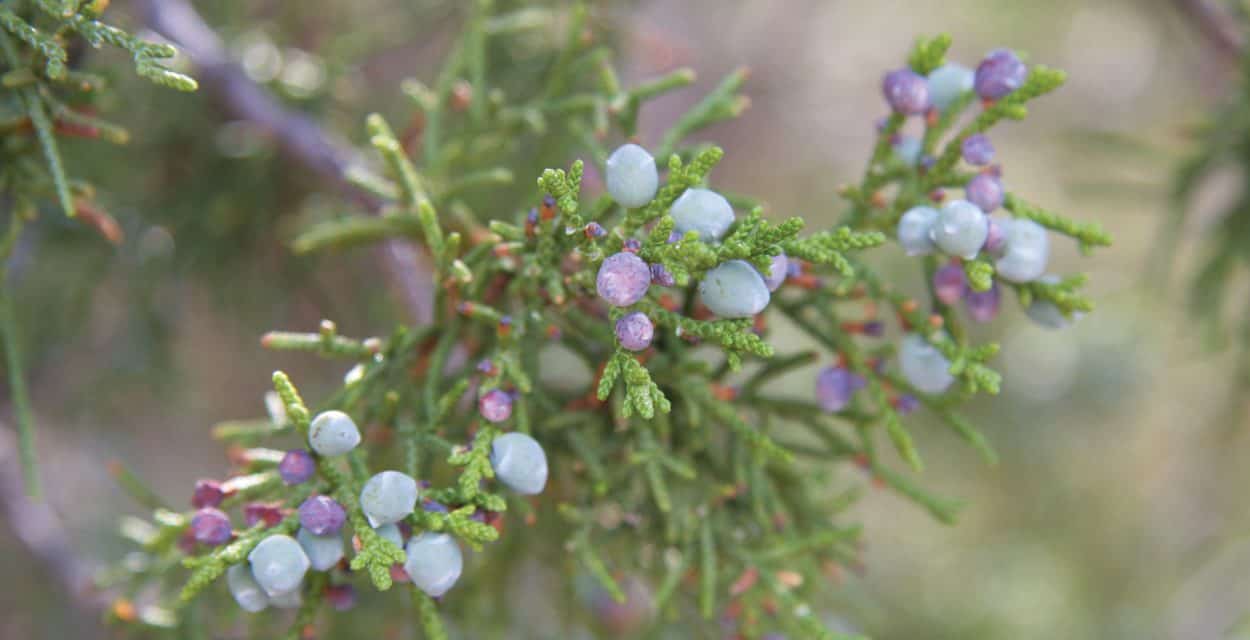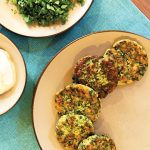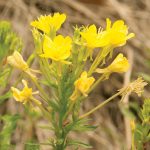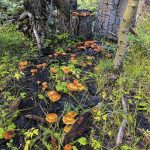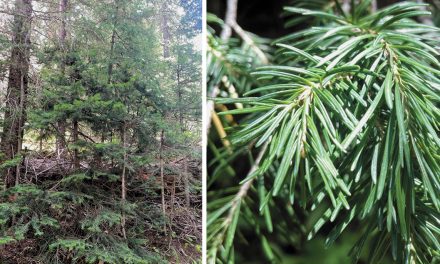Words and Photos by Ellen Zachos

Many New Mexicans dread the onset of juniper season, when massive clouds of pollen keep people with allergies indoors for weeks at a time. But I’m here to praise our native junipers, which are tough, attractive, drought-tolerant plants that provide significant shelter and food for birds, insects, and mammals, including human foragers.
We have lots of junipers to choose from in New Mexico; some are shrubs (multi-stemmed) and some are trees (single trunks). All of them produce edible fruit. One-seed juniper (Juniperus monosperma) is our most common species. It grows in dry habitats between 3,000 and 7,000 feet. Rocky Mountain juniper (J. scopulorum) grows at higher elevations, alongside ponderosas and Douglas firs. Common juniper (J. communis) is usually found from 8,000 to 11,500 feet in New Mexico, while alligator juniper (J. deppeana) grows from 4,500 to 8,000 feet. Additionally, small pockets of Utah juniper (J. osteosperma) are found in northwestern New Mexico, and both redberry juniper (J. coahuilensis) and Pinchot’s juniper (J. pinchotii ) are found in small numbers in the southern part of the state.
Junipers are scale evergreens. Their leaves look like tightly overlapping scales rather than needles or large, flat leaves. And junipers are dioecious, meaning male and female flowers are borne on separate plants. Male plants are responsible for the clouds of allergenic pollen in late winter. The tasty fruit is a joint effort of both male and female plants.
Depending on the species, juniper fruit may take one to two years to ripen, so it’s not unusual to find both green (unripe) and blue-red (ripe) fruit on the tree at the same time. And while ripe fruit makes an excellent trail nibble, unripe fruit is intensely bitter. Unless you’re harvesting to make bitters, stick to the ripe fruit.
I’m often asked if juniper berries are safe to eat, and there’s some controversy about this. The berries from our native varieties are safe; however, the bark of J. sabina, savin juniper, can be toxic to cattle when eaten in large quantities, and there’s no consensus on the toxicity of this variety’s berries. Additionally, J. sabina isn’t native to this country, so you’re unlikely to come across it while foraging in the wild—but you might want to avoid picking berries off ornamental junipers or trees in gardens and parks unless you can confidently distinguish one species from another.

Juniper with white bloom on the berries.
Sure, you can find dried juniper berries in good spice stores, but with so much juniper all around us, why not forage for your own? The fruit of J. communis is generally considered to be the tastiest (it’s the species most often used to flavor gin), but it’s worth sampling the fruit of all our native species. Juniper fruit has both bitter and sweet elements. It’s a complex flavor, sometimes described as citrusy and evergreen, reminiscent of rosemary. And in addition to being the most familiar flavor in gin, juniper fruit is also a traditional sauerkraut spice. It makes a delicious ingredient in dry rubs and is the base for a naturally fermented Balkan beverage known as smreka, sometimes called Balkan lemonade.
The key to making smreka is the white bloom on juniper berries, which is a waxy covering secreted by the juniper fruit’s skin that indicates the presence of yeast. That yeast is what makes naturally fermented smreka possible. While you may find recipes online that call for adding lemon to the brew, I think it’s plenty sour without it. Try making your first batch with just juniper fruit and water; you can always add lemon later.
Combine 1/2 cup juniper fruit with 2 cups non-chlorinated water in a jar with a tight-fitting lid. Cover the jar, shake it, and put it somewhere out of direct sunlight, where you can keep an eye on it. Shake it once a day. As the smreka ferments, the water turns yellow and most of the fruit sinks to the bottom of the jar.
After 30 days, strain off the fruit and pour the liquid through a coffee filter to remove any small particles. Because there is very little sugar in juniper fruit, and because yeast feeds on sugar, this will be a lightly fermented beverage. And while technically speaking there must be some alcohol in there (because . . . fermentation), it is pretty much indiscernible.
Refrigerate your smreka and taste it cold. You’ll probably want to add a little honey, but that’s up to you. Enjoy it plain, over ice, or substitute it for lime juice in a margarita!

Fermenting smreka.

Ellen Zachos
Ellen Zachos lives in Santa Fe and is the author of eight books, including the recently released The Forager's Pantry. She is the co-host of the Plantrama podcast (plantrama.com), and writes about wild foods at backyardforager.com. Zachos offers several online foraging courses at backyard-forager.thinkific.com.

